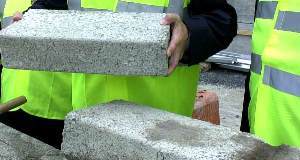Greencore shares hit by Asda beef bolognese sauce & horsemeat scandal


Shares in Greencore fell today as British retailer Asda withdrew beef bolognese sauce supplied by the firm that tested positive for traces of horse DNA.
The Irish food group’s stock fell by up to 22 per cent earlier today, the most it has dropped in 14 years, reducing its value by as much as £89 million.
However, the stock pulled back some of its losses on the London market, and was trading just under 10 per cent lower this afternoon.
Greencore became the latest company to become embroiled in the horse meat scandal when it confirmed it manufactured bolognese sauce that was found to contain horse meat. Asda withdrew three other Greencore products “as a precautionary measure” but they did not test positive for equine DNA.
In a statement, Greencore said the beef was supplied to it by the ABP Food Group’s Nenagh plant in Co Tipperary. The Larry Goodman-controlled ABP also owns Silvercrest Foods, whose factory in Co Monaghan was one of the first whose products tested positive for horse DNA last month.
Figures show drop in Irish building trade work

The number of large extensions and new housing developments being built dropped by 8% last year.
Latest figures revealed just 5,297 projects started nationwide in 2012, down from almost 5,750 in 2011.
However six counties bucked the trend, including Westmeath where the number of developments soared by 39%.
Works featured in the national housing construction index include all home builds from extensions that need planning permission and detached homes to housing estates. Elsewhere it showed the number of people applying for planning permission dropped in every country nationwide, except in Donegal where it jumped by 20%.
Danny O’Shea, managing director of Link2Plans which compiled the report, said the index reveals a slow down in the rate of decline in planning applications and commencements.
He said: “This is a trend that we saw in previous volumes of our index. Looking back at the whole of 2012, the numbers show that while commencements are down 8%, six counties all saw an increase. If these trends continue into 2013, we could expect to see numbers potentially rising in the first half of this year which is potentially very positive news for the sector as a whole.”
Link2Plans said commencement notices give a real time report of construction activity, as one must be issued to a local authority within a month of work starting.
The largest fall in notices was recorded in Roscommon (-30%), Laois (-27%) and Donegal (-27%), while there were increases in Westmeath (39%), Mayo (29%), Sligo (25%), Cork (6%), Wicklow (6%) and Kilkenny (1%).
Elsewhere planning applications fell in every county except Donegal, where they rose from 1,067 in 2011 to 1,277. The largest percentage drop was experienced in Kildare (-34%), Kerry (-32%) and Clare (-32%). In Dublin planning applications were down by 252 (10%) and commencement orders by 55 (5%), while in Cork the figures were down 500 (-21%) for planning applications but 33 extra building projects started.
Mr O’Shea said the register contains tentative signs of hope for residential construction sector. He added: “While there was a fall in both applications and commencements, the fall has slowed down.”
Computer system helps to identify suicide risk

A computer-based system which can help to identify those at risk of suicide has been developed by researchers at NUI Maynooth.
According to its department of psychology, it can correctly identify those who are experiencing suicidal thoughts with 75% accuracy.
The system, called the Implicit Relational Assessment Procedure (IRAP), requires participants to confirm or refute statements under time pressure. Reaction times are tracked and passed through a computer algorithm which is used to reveal unconscious attitudes or biases that are used to predict actual behaviour.
Trials of the system have been conducted over the past year with 24 service users from St Patrick’s University Hospital in Dublin, Ireland’s largest independent mental health hospital.
“Some of the most difficult behaviours to predict are those that occur very rarely but have large and devastating consequences, such as suicide,” said Prof Dermot Barnes-Holmes, who developed the test in conjunction with PhD student Ian Hussey.
“Ireland is no stranger to the issue of suicide and we have higher rates than the European average, especially among young men.”
To date, research into suicide has largely focused on long-term suicide risk factors to indicate whether someone is at an increased risk over many years — analysing factors such as hopelessness, serious health complaints, and previous suicidal behaviour. The NUI Maynooth project focuses on short-term suicide risk assessment.
The research project, which is funded by the Irish Research Council, is a finalist for the upcoming “Making a Difference” awards run by the Higher Education Authority to acknowledge useful postgraduate research work.
Mr Hussey said the test was less invasive than traditional methods that required people to talk openly about their struggle with suicidal thoughts.
“We hope that this research could significantly impact how hospitals and doctors can assess individuals who present at hospitals and A&E with mental health complaints, helping to identify priority cases in terms of psychological care.”
Cancer often preventable, British Columbia researcher says
Cancer may be one of the leading causes of death, but a British Columbia researcher says at least half of the cases are preventable.
Carolyn Gotay said P.E.I. has made improvements when it comes to some of the preventable factors that can cause cancer, but the province still has room to improve further.
“If there’s any consolation, so does every province,” she said.
Gotay, who is the Canadian Cancer Society’s chair in cancer primary prevention at the University of British Columbia, was in Charlottetown Wednesday for the group’s kickoff of the annual Relay for Life fundraising campaign.
This year, the Queens County relay will be held June 7 at the Red Shores driving park in Charlottetown.
The Canadian Cancer Society will hold six relays in total, including in Kensington and at UPEI.
Last year, the Queens County relay raised more than $141,000, while P.E.I. raised a total of more than $400,000 for the Canadian Cancer Society.
Bill Whelan, the Canadian Cancer Society in P.E.I.’s president, said the Relay for Life is more than just a fundraiser.
“It’s a community experience,” he said.
During her speech, Gotay said last year there were 880 new cases of cancer in P.E.I. and 380 deaths expected.
“Numbers are sobering but 50 per cent of cancers could be prevented from ever happening in the first place.”
Gotay said most people aren’t aware that can be preventable.
“It seems like something that comes on in the night, there weren’t any warning signs, there’s nothing that could be done,” she said.
Some of the leading causes are tobacco use, poor diet, inactivity and obesity, although Gotay said there are other factors people
have no control over, such as genetics.
Changes take time, she said, and she used lower smoking rates as an example of behaviour that gradually changed.
“You don’t see changes happen overnight.”
Gotay said one of the biggest things that needs to be done is build what she called an
infrastructure of researchers to train people about cancer prevention.
“I think we don’t have enough people and we don’t have enough training programs,” she said.
Cancer prevention needs to move from the research level to what people put into practice with policies in place to support them, she said.
“There has to be an integration for a societal level effect to be made.”
Chimpanzee monkey minds much like us humans, In some ways they are better


At Kyoto University’s Primate Research Institute, a chimpanzee named Ayumu is performing a task that is impossible for a person to do, revealing how chimp cognition can mirror — and in some cases surpass — the capabilities of the human brain.
Sitting in front of a computer monitor that briefly displays the numbers one through nine in a random pattern, the chimp touches the number one. The remaining digits are immediately hidden behind white squares. But Ayumu can touch where each number was, in ascending order – 2, 3, 4, and so on. People cannot remember the location of more than a few numbers.
At the annual meeting in Boston of the American Association for the Advancement of Science, researcher Tetsuro Matsuzawa showed a video demonstrating Ayumu’s extraordinary working memory. He suggests that although humans cannot match that skill, we don’t need to, because we have language.
“Chimpanzees are so good at memorizing things at a glance. We are not so good at memorizing things at a glance, but we can see the things and perceive the meaning of what we see,” he says.
Other research presented at the AAAS meeting, highlighting the similarities between primate and human minds, found occurrences of human-like depression, post-tramatic stress disorder and anxiety disorders among captive great apes. These studies have helped fuel a growing movement to stop using primates as research subjects, or at least to put new ethical guidelines in place to protect lab primates from cruel or inhumane treatment.
Hidden cameras capture incredible pictures of elusive animals
“The images can provide the world with an essential picture of how life on Earth is changing.”
One of the world’s most elusive animals has been pictured in the tropical forests of Peru – a fitting way to mark the one millionth image captured by a wildlife team undertaking vital conservation work.
The remarkable image of the rarely seen jaguar – which comes 12 seconds into the video featured below was taken in Manu National Park by a hidden camera, one of many placed on a grid system in forests through Africa, Asia and Latin America.

The elusive jaguar is pictured in Manu National Park
The remote cameras use motion sensors to automatically begin filming when it detects movement, signaling that an animal is nearby.
The images of creatures in their natural habitats seek to reveal how unseen animal populations are being affected by changes in climate, habitat and land use.
The first published results from the study, which shows data from 2011, revealed that mammals were becoming less diverse and smaller due to poorer diets.
The project has been undertaken by the Tropical Ecology Assessment and Monitoring (TEAM) Network.
Dr. Jorge Ahumada, the team’s Technical Director, said: “The one-millionth image is an amazing representation of our camera trap work, and it symbolizes the success we have had with this program in collecting new data.
“As we celebrate this accomplishment, we are also at a critical point in beginning to provide information to decision makers from the local to global level on how biodiversity is affected by climate change and habitat loss.”
Dr. Sandy Andelman, Senior Vice President of Conservation International and Executive Director of the Team Network, added, “Most conservation science today isn’t ambitious enough.
“Through the millionth camera trap image team is demonstrating that the right technology, applied at the right scales, can provide the world with an essential picture of how life on Earth is changing.”
The Team Network is a partnership between Conservation International, Missouri Botanical Garden, Smithsonian Institution and the Wildlife Conservation Society and is implemented through over 80 local partner institutions.




No comments:
Post a Comment